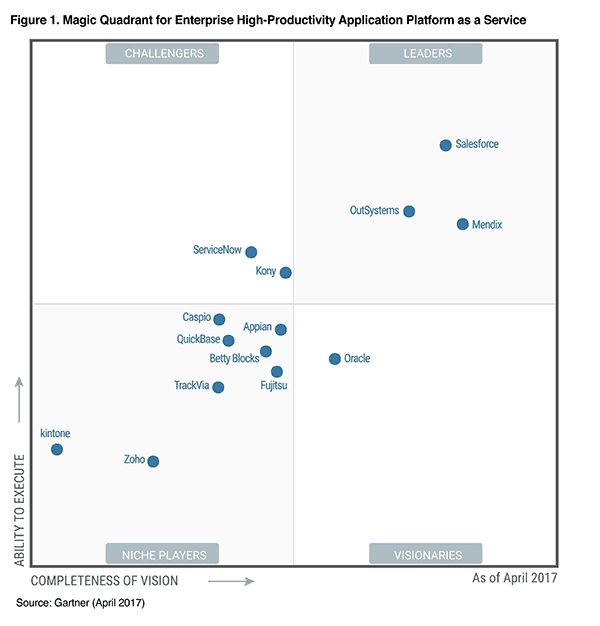Last Friday, Gartner published their first ever Magic Quadrant for High Productivity Application Platform as a Service (or hpaPaaS). I’m delighted to tell you that not only is Mendix positioned as a Leader within the MQ, but we scored the highest of any vendor in the MQ for Completeness of Vision.
At Mendix, we’ve long believed that the right blend of rapid development, a cloud-native architecture and enterprise worthiness creates the shortest path for delivering innovative apps that empower individuals and drive success. It’s incredibly gratifying to see the emergence of an MQ dedicated to such offerings, as well as for the market to embrace and validate that vision.

“These hpaPaaS solutions enable the enterprise to utilize a full range of developer assets — citizen developers, departmental developers and enterprise IT professionals — and develop applications ranging from tactical to strategic and stand-alone to integrated.” [1]
When talking about high productivity or low-code development, it’s tempting to focus on speed as the defining characteristic. Indeed, time to value is the primary goal. But delivering it, particularly in an enterprise context, requires many more dimensions than just raw development speed. Recognizing this, Gartner’s criteria includes a number of additional platform characteristics, notably:
- Degree of cloudiness
- Enterprise worthiness
- Openness
- Architectural versatility
The mission behind our platform is to allow customers to take ideas for improving and transforming their businesses from initial ideation to large-scale production, in the minimum length of time. So it’s incredibly rewarding to be recognized not just by Gartner in the MQ, but also by our customers for high productivity, user experience, cloudiness, ease of use and administration, and time to results. These are all things we care deeply about.
The mission behind our platform is to allow customers to take ideas for improving and transforming their business from initial ideation to large-scale production, in the minimum length of time.”
Low-code (or no-code) development often implies the creation of simple, lightweight apps. At Mendix, we strive to ensure that our customers aren’t limited with respect to the kinds of applications they can build. As mentioned in the MQ, the Mendix modeling approach supports sophisticated data-driven and process-oriented applications, and can even be used for high-volume transaction processing. And our approach to extensibility—through connectors and 3GL code extensions—aims to put increasing power and capabilities in the hands of no-code developers. We will continue to build upon this approach as the world advances in the direction of Smart Apps that leverage emerging technologies like IoT and Big Data, as well as a “post-app” future where the human-machine interface disappears.
For solutions to provide their intended value they must be deployable at scale, appropriately governed, and of course robust. To that end, the MQ highlights some of our key run-time and operational capabilities, such as:
- A multicloud architecture, leveraging Cloud Foundry and Docker, that allows customers to deploy on AWS, Microsoft Azure, Pivotal, SAP HCP or virtually any other infrastructure.
- The ability to deploy on-premises or in a hybrid model.
- Configurable high-availability when running in the Mendix Cloud.
We invest significantly in our run-time and server technology, for the simple reason that we want to ensure that our customers can deploy solutions at any scale and with any degree of governance that they need.”
To that list, I’d also add self-service horizontal scalability as well as enterprise-grade security and governance. In fact, I’d argue that it’s the kind of run-time environment that many would associate with high-control platforms, while shielding the developer from complexities that they shouldn’t need to be concerned with. We invest significantly in our run-time and server technology, for the simple reason that we want to ensure that our customers can deploy solutions at any scale and with the degree of governance that they need.
The MQ also highlights the Mendix ecosystem and our public App Store. The latter contains an ever-expanding array of apps and add-ons (currently over 400), including modules, connectors, widgets, themes and app services. What makes the App Store so valuable, though, is the vibrant community of customers, partners and individual developers that power it. There are over 40,000 community members as we speak, who actively engage and support each other. In fact, 80% of questions asked within the community forum are answered within one hour.
What makes the App Store so valuable is the vibrant community of customers, partners and individual developers that power it. There are over 40,000 community members as we speak, who actively engage and support each other.”
It’s a tremendous honor to be recognized as a leader within the 2017 hpaPaaS MQ. It takes every single person at Mendix as well as the Mendix community to drive the platform forward and ensure our customers’ success—the basis of being worthy of such an acknowledgement. We look forward to continued collaboration with you, our community of customers and partners, to help you realize the real-world benefits of your ideas.
[1] “Magic Quadrant for Enterprise High-Productivity Application Platform as a Service” – Paul Vincent, Van L. Baker, Yefim V. Natis, Kimihiko Lijima, Mark Driver, Rob Dunie, Gartner, 27 April 2017